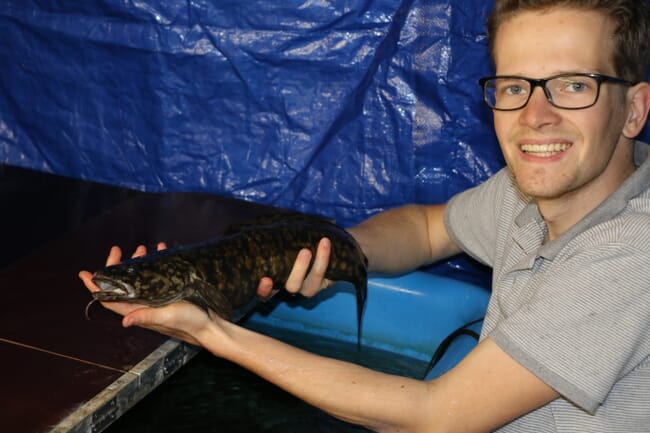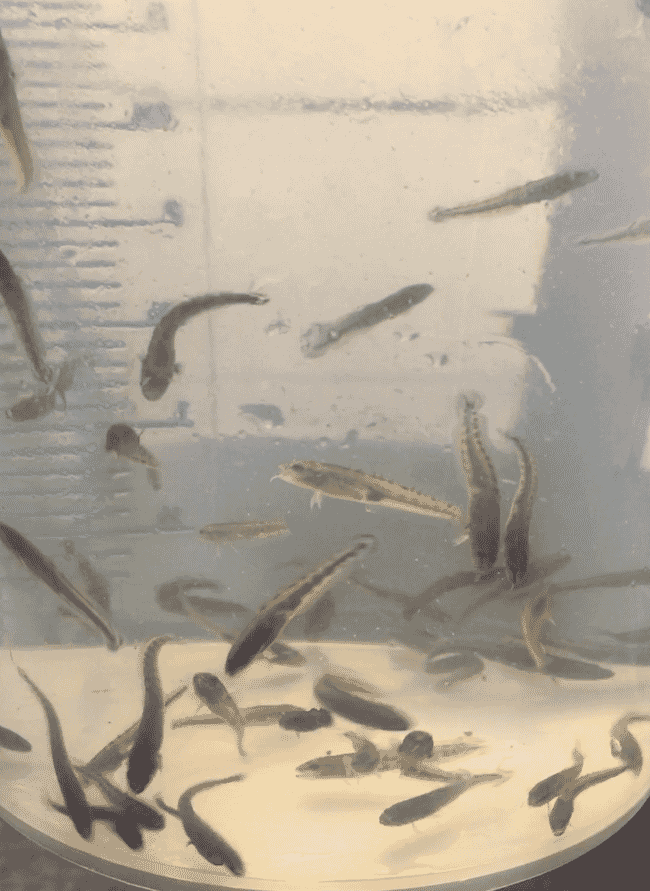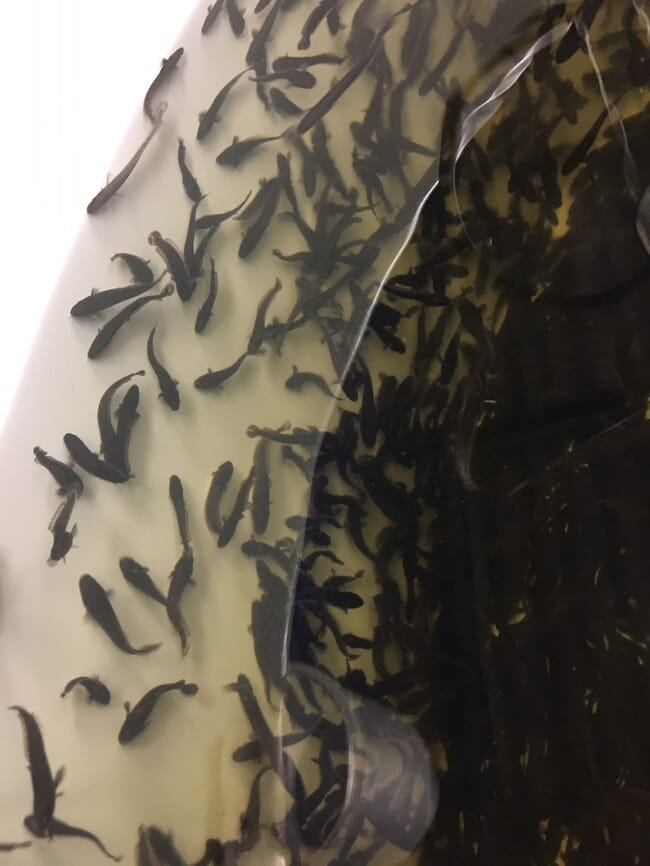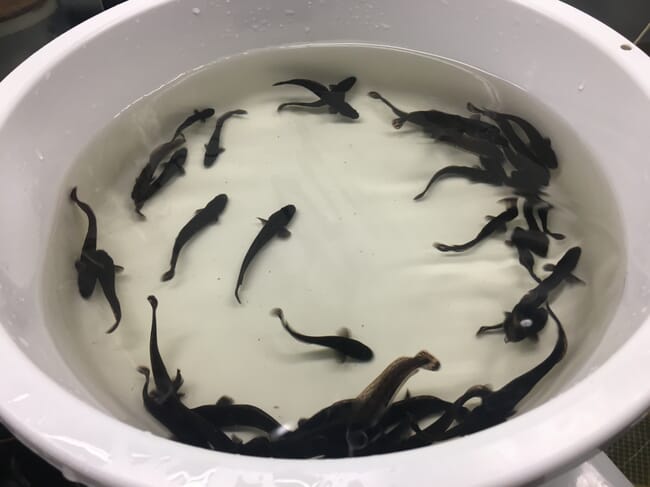
What inspired you to set up Aqualota?
I’ve always been interested in fish and aquatic ecology. When I was young, I always looked at koi ponds or in rivers and lakes, and seeing the fish and paying attention to how they were interacting with their environment – wondering, for example, why I saw more fish when there were more insects.
Over time this evolved, and during the last year of secondary school, I visited a fish farm owned by the Flemish government at the Research Institute for Nature and Forest (INBO). It’s a small farm, where they started-up a conservation programme for a number of rare and endangered species (bullhead, burbot, northern pike, brown trout, lamprey ) via controlled cultivation and re-introduce them in the environment. This visit shifted my interests from aquatic ecology to aquaculture. This was also the first time that I came into contact with burbot. For most of Europe, burbot has been added to the “threatened” or “extirpated” list. In Belgium, Germany, Austria, the Czech Republic, Switzerland, France, the Netherlands and the UK it’s officially an endangered red-list species, or extinct.
After that, I went to Odisee University of Applied Sciences for my bachelor’s degree in agriculture and biotechnology with a major in food science. The main reason I choose Odisee was that they have an aquaculture research centre, Aquaculture Education & Research Facility (Aqua-ERF) and burbot was one of the major research topics. After graduating, I started working at Odisee while taking part in the master’s in aquaculture at the University of Ghent.
How difficult was it to set up the farm?
It was stressful and I felt like I had everything against me. I was young, I didn’t have a lot of experience and Belgium has very few aquaculture producers to ask for advice. My father and I had to find out [what to do] mostly by ourselves. So we followed an introduction course in aquaculture organised by Odisee and started experimenting with RAS. I’ve gained insights into reproduction and fingerling production by doing internships at INBO and Aqua-ERF. Over time, we had some failures, we had some successes. It’s been quite a journey to get where we are now.
We’ve now got both the experience and background and are ready to increase our production. I’ve got experience in reproduction and larviculture with multiple commercial cultured species now – such as pikeperch – and I like learning new things every day. It’s not good to have tunnel vision.
Why burbot?
In 2010 the Belgian government decided to ramp up the aquaculture sector. A group of stakeholders worked together under the EU on Interreg-project AquaVlan, a cooperation programme between the cross-border regions of Belgium and the Netherlands. They drew up a list of different species that could be interesting for aquaculture. In Belgium, the Odisee University of Applied Sciences decided to pick burbot where other institutes picked pikeperch (Inagro) and jade perch (Catholic University of Leuven). In the Netherlands, they researched salty vegetables, shellfish (HZ University of Applied Sciences) and yellowtail kingfish (Imares) The latest also resulted in a spinoff of that original research project (Kingfish Zeeland).
This led to some research on the different aspects of burbot culture. At first, Aqua-ERF was looking into the ongrowing of the species in RAS. But since the availability of fingerlings was a limiting factor for further research, they soon performed the first trials with larvae in 2011, together with Ghent University’s Laboratory of Aquaculture & Artemia Reference Center. Larval rearing has been its main focus point for a number of years.
I was doing internship at Aqua-ERF as a student at the time, so I had the opportunity to experiment with their systems and get hands-on experience. I made the decision pretty early on that burbot had potential, so decided to give it a try. Today, there is sufficient insight and experience to start up the commercial culture of the species, owing to the projects of Odisee.

What are the major challenges in burbot husbandry?
Burbot is a nocturnal freshwater species, and quite a lot of aspects of its lifecycle are challenging: it reproduces at 4°C, so everything evolves slowly – depending on the temperature, the egg incubation takes up to one-and-a-half months, sometimes even two months. During that time anything that can go wrong might go wrong, along with conventional hatchery issues like the development of fungi that kills the eggs – it’s a very prolonged and labour-intensive period.
The larvae have a real larval stadium and are quite a demanding species, resulting in a culture methodology similar to marine species such as sea bream or Atlantic cod. Once they hatch, they need over 50 days of live feed, unlike most freshwater fish, which can be fed on microparticulate diets almost as soon as they hatch. Once they are a few weeks old and the eyes are better developed, they are quite aggressive eaters and we have to pay constant attention to signs of cannibalism and perform regular grading.
Odisee is currently looking into artificial out-of-season reproduction in RAS. Because, at the moment, we can only produce fry during one period of the year. The preliminary results are promising, but we need additional research to standardise this practice.
How about for the grow-out phase?
Once they have been converted to dry feed and reach 5g to 10g, the requirements for burbot are similar to salmonids – they need really clean water. As for the temperature range, they are being cultured anywhere from 10°C to 18°C, but a water temperature of 14°C to 16°C seems to be optimal. In RAS, with proper husbandry conditions, optimal thermal conditions and automatic feeders, they grow out to 500g-600g in around 12 to 15 months; in flow-through they will reach this size in 1.5-2.5 years, depending on year-round temperatures. Take into consideration that since no specific diet for burbot is available on the market, there is much room for optimalisation. Thus, developing a diet for this species would increase the growth.
Most of our customers are ongrowing the burbot in RAS, some in flow-through. One advantage of burbot is that it’s a benthic species – it rests and lives on the bottom. This means you only need the water to be around 40cm (16 inches) deep, which in turn means you can grow them in stacked raceways. In an ongrowing experiment, Aqua-ERF cultured the fish at different densities of 60kg to 100kg per square metre in a commercial RAS set-up without problems and with good growth rates. Some farmers also use the fish in polyculture with salmonids like brown trout, char or rainbow trout.

© Joachim Claeye
Where did you get your original broodstock from?
It was difficult finding broodstock. But with the assistance of some institutes, I was able to obtain them from three river systems: the Rhine, the Elbe and the Oder. I’m also thinking of sourcing Scandinavian broodstock in the near future, as these might have different traits.
What traits are you looking to develop?
Burbot have a really good feed conversion ratio – in Aqua-ERF’s early research, in 2010, they thought they were doing something wrong, because the feed conversion ratio averaged 0.8 – you only need 800g of feed to produce 1kg of fish. That’s quite good for a carnivorous species that is at the top of the food chain. The logical next step would be looking into the nutritional requirements during different life stages, formulating diets for this specific species with (partial) replacement of the fishmeal and fishoil in the diet with more sustainable raw materials such as single cell protein, or insects. The fish is also more disease-resistant than salmonids.
I’m mainly focusing on the morphology of the fish – we’re trying to get the ideal size for processing and fillet yields. Growth is also something we select for, but we don’t want to push this too far, because we don’t want to create some sort of aquatic chicken. If you focus too much on one trait, it will potentially have a negative impact on another one. It’s like having a Ferrari: all that horsepower doesn’t necessarily mean that you will arrive at your destination faster or safer. Our main focus is to improve the economic efficiency for our farmers.
Are there a lot of burbot producers in Europe?
For commercial fingerling production, it’s me and one other person in Germany. We’re both focusing 100 percent on burbot, having control over the entire lifecycle, and transitioning the fingerlings onto dry feeds. We have good contacts with each other and other institutes which have previously worked with the species.
Do you interact with other producers?
I try to be open – it’s a new species and it’s important to share experience – and for some producers this is indeed [what they do], but with many fish farmers, business is business, which can be frustrating.
Grow-outs often ask for my input because I produce the fingerlings. But then, grow-out farms, to whom I give the same information, often don’t talk to each other! One of our objectives for the near future is the formation of a thematic group on burbot. Only by getting the different (international) actors together around the table (both producers and researchers) can we reach our full potential.
Who are your main customers?
In the past, I’ve been contacted by fisheries agencies who want to purchase fingerlings for reintroduction into the wild, but I’m more focused on production for human consumption. Some of my customers are people who are farming as a secondary occupation, like me. They are often people with different backgrounds. For example, one of them has integrated burbot into his vegetable-growing business (they have high-quality water available anyway); another is a software developer.
The second group consists of people who are already working in aquaculture full time, but don’t want to produce the fingerlings, or they don’t know how to produce them. So they purchase fingerlings from me, to grow in their farms alongside other freshwater species, like salmonids, perch or pikeperch. Often these companies are doing the production, the slaughter and the sale. So there are a lot of family-owned companies. Local food production, from farm to fork, is gaining momentum in Europe, and this also creates opportunities for small- to middle-scale aquaculture.
How is burbot processed?
You can’t really descale a burbot. It’s more of a leathery hide – there’s a Swiss college that’s making watch straps and wallets with burbot skin – so you need to skin the fish. Some of the farms make fillets out of them, others chop the fish up into big pieces – it depends on how you want to market them.
In America they call it freshwater lobster, and I’m told it tastes like scallops when fried. I’ll have to try it myself, but I don’t feel like slaughtering my broodstock. So I’ll have to wait another year to test it out. From my experience, the fish is much more firm than cod and also tastes somewhere between turbot and monkfish. Maybe that’s why they call the fish la lotte de rivière in French, from the French for monkfish, lotte. Burbot is a lean fish; the lipid level in the fillets is very low compared to eel or other species. As far as I’m aware and based on my own experience, there are no issues with off-flavour, which also is a huge plus. Fish of 500g result in fillet and liver contents of around 40 percent and 10 percent respectively. The liver, which is naturally big, can be marketed as a niche product, either by itself or converted to pâté to be used as a substitute for foie-grass. One of Odisees’ students made a recipe for pâté with ingredients such as juniper berries and lemongrass, which was quite tasty as an appetiser.

© Joachim Claeye
Why does Belgium have such a small aquaculture sector, and do you think it will gain momentum?
There are a lot of issues. First, we’re a small country, and despite having a small coastline, our consumption is mainly marine species-based. Even with fisheries factored in, we only produce around 8 percent of the seafood we consume, so we’re mass importing marine and freshwater fish from other parts of Europe and Asia. Plenty of opportunity for local growth if you ask me!
Also, Belgium doesn’t really have a tradition of aquaculture as is the case in Germany, the Czech Republic or Poland, for example. We have some trout farmers in the southern region, but the average age of the people working in those farms is very high – pensionable age. Since there is so little production, there was also little education available on the subject. To tackle this, Odisee formed an introductory course in aquaculture. It won’t make you a fish farmer, but it can certainly give you a better insight [into the business] and the required background information to become active in the sector.
I also believe that one particular operation set us back. We had the biggest tilapia recirculation farm in the world at one stage. However, it went bankrupt in 2009 after two or three years. They had a lot of money, convinced a lot of investors and I believe that local banks and the government were backing the company, so when it went bankrupt, people noticed. Even now, when I go into a bank looking for a loan, almost immediately the bank says “no”. Aquaculture is still new for them, and they remember that specific case.
In 2012, the initial consortium of the Belgian partners in the Aquavlan-project had been extended with additional stakeholders and officialised by the government. This strategic committee, named Flemish Aquaculture Platform, is being chaired by Professor-Emeritus Patrick Sorgeloos. The different stakeholders that are present in this group are diverse, such as scientists and academics from government agencies, universities and colleges, but also farmers, feed producers, retail and consumer organisations, which is helping us gain momentum.
Until then, we only had a handful of smaller companies and one really well-known company in aquaculture: Inve Aquaculture. Now we have multiple new companies active in a wide variety of subjects, and new producers: an omega perch (jade perch) farm, which is actually a form of aquaponics since they exchange water with a nearby tomato farm. There is another aquaponics farm in Brussels working with striped bass, there’s a pikeperch fingerling operation near the Dutch border and a super-intensive biofloc shrimp farm – and, last but not least, our company, Aqualota. So it’s still small, but we’re gaining momentum. It’s coming up – not as fast as the rest of Europe, but there are a lot of people interested.
How would you like your own operation to develop?
We’re currently expanding the operation to produce around 150,000 fingerlings annually. I want people to see how burbot can be cultured, and how the systems work, so we’re going to do some grow-out ourselves of a few tonnes a year – small enough not to compete with commercial producers but big enough to be economically feasible. I think that’s a good plan, as it will provide more insights into more aspects of the entire burbot lifespan, which will also allow me to give my customers better advice.
As for the future, I hope that we will not only be able to increase fingerling production, but also start working with a second niche species. But first thing’s first!




